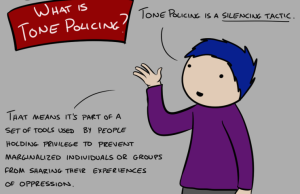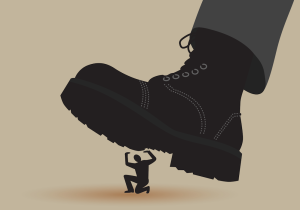Thanks in no small part to viral hashtags, celebrity advocates and dozens of other landmark pop culture moments, it seems that public opinion about feminism is finally changing.
But while this decreased stigma is encouraging, it seems the dominant understanding of feminism — and the many damaging forms of inequality it addresses — is still lacking.
Here are just eight things feminists still have to explain to others — and which we all hope will one day be common knowledge.
1. Women like sex.
Our society may uphold two extremes when it comes to women’s sexuality (virgins or whores) without much room for identities in between, but this double standard is bullshit.
Women not only enjoy sex, but also occupy a variety of sexual identities, behaviors and preferences.
Women have distinct sexual fantasies. They watch porn. Plenty of women like casual sex, and they aren’t programmed to pursue monogamy.
They also identify as lesbian, bisexual, asexual and even reject labels altogether.
There’s hardly an expiration date on these identities and behaviors: A recent survey found the majority of women over 60 who are married or living with someone are sexually active.
It’s time to dispel the myth that female sexuality extends only to pleasing male partners or reproducing.
2. Women deserve to have authentic media representation.
Women are still vastly underrepresented in media across the board: In 2014, women accounted for only 12% of on-screen protagonists and 30% of characters with speaking roles, according to the Women’s Media Center’s 2015 report.
Even when female characters do exist, they are far from complex or representative of the range of women’s experiences. One Tumblr user pointed out in March that female Pixar cartoon characters suffer from “same face syndrome,” whereas male characters are aesthetically diverse.
Similarly, a BuzzFeed census of Disney characters revealed that most leading female characters were younger than 20 years old, about 71% were white and about 57% were married or about to be by the end of the film.
But while some may write this off as annoying or lazy, these representations send a clear message and especially influence young viewers. Representation meaningfully shapes and reflects society’s attitudes towards women and the broad expectations we hold for them.
Studies demonstrate that not only can media representation affect the way women see themselves, but also that witnessing powerful female characters can positively shape audiences of all genders’ perceptions of women.
Putting more female characters on screens (and more complex female characters at that) is not just a matter of parity, but a meaningful indication of — and avenue for generating — progress.
3. Inequality is the enemy, not men.
Feminism is a movement dedicated to gender equality. Yet plenty of people still interpret feminism as an effort to prioritize women over other groups — like, for example, the many Men’s Rights Activists who believe feminists are concerned with destroying men by falsely accusing of them of crimes like rape and denying them other rights.
In reality, feminists do not want to destroy or hate men, but rather alter social, political and economic structures so that people of all gender identities can live equally.
The existing system, known as the patriarchy, doesn’t only disadvantage women but yields multiple types of oppression, including forms that hurt men.
This is why men are not only capable of identifying as feminist, but can benefit from the movement as well.
4. Reproductive rights are not privileges.
In 1973, the Supreme Court effectively prohibited states from outlawing abortion through its landmark Roe v. Wade decision. Yet 51 statewide abortion restrictions have been passed in the first half of 2015 alone, according to the Guttmacher Institute.
This results in a cultural landscape where governments regulate what people who get pregnant do with their bodies and other people add cultural enforcement, as anti-choice activists continue to target and even terrorize and murder abortion providers.
Yet these harsh restrictions don’t effectively reduce abortion rates. Even when states restrict abortions, people will still make the choice that makes sense for them; many travel to neighboring states to obtain the procedure, Sarah Erdreich, author of Generation Roe: Inside the Future of the Pro-Choice Movement, told Mic in June.
What these restrictions do effectively accomplish is further disadvantaging already marginalized groups and bolstering abortion stigma.
Young, poor and single women are the least likely to have access to safe abortion in this landscape, and women of color face similarly disproportionate barriers to this right.
5. Choosing traditionally feminine roles isn’t inherently anti-feminist.
When it comes to choices about traditional gender roles, it seems that women today can’t win. For example, if women choose not to become mothers, they’re considered shallow or selfish.
But if they do and then decide to stay home with their children, they’re somehow failing womankind.
While many women have fought for the simple right to make choices, others have noted that some choices still stem from internalized misogyny and abet a patriarchal system.
The more productive viewpoint, therefore, may be to focus less on praising or criticizing the actual choices women make, and more on questioning the systems that create the conditions for those choices.
Instead, Andrea Grimes wrote in 2013 for RH Reality Check, women should be celebrated when “they choose to fight, to rebel, to challenge, to speak up.”
6. Body image isn’t just a superficial concern.
The numbers are staggering: Eighty percent of 10-year-old American girls have been on a diet, more than half of girls age 6 to 8 indicate their ideal bodies are thinner than their current bodies and an estimated 1.3 million adolescent girls have anorexia, according to a Common Sense Media data review released early this year.
Behaviors that come with this reality, like disordered eating, are overwhelmingly normalized, as body image issues are largely seen as part of being a woman in this society rather than a serious problem.
The truth is, these attitudes are holding women back in myriad ways. The proven correlation between negative body image and low self-esteem, for example, can shape how confident they are and even affect their sexual pleasure.
This valuing of thin bodies is not just internally felt: Overweight women are more likely to be paid less, according to a 2014 study.
Body image may concern one’s appearance, but that doesn’t make it superficial, and women shouldn’t have to explain this or defend their experience with it.
7. We’re still working toward equality at work.
When the public learned that FIFA paid 2014 Women’s World Cup competitors 40 times less than their male counterparts, outrage ensued. This is hardly the first or only instance of women being paid less in the sports world, let alone the rest of American and global society.
Pay isn’t the only form of workplace discrimination women still face. Although Anita Hill paved the way for women to discuss sexual harassment in the workplace more than 20 years ago, one 2015 survey found that 1 in 3 women still reports having been sexually harassed at work.
Plenty of women also more anecdotally discuss the persistence of the “glass ceiling” and the fact that women are still vastly underrepresented in a variety of fields. Congress is only 20% female, women hold a mere 14.2% of the top five leadership positions at companies in the S&P 500 and in 2013, they held just 26% of computing jobs in the U.S.
Just because women have come a long way in terms of work opportunities and professional success doesn’t mean we’ve achieved victory in the fight for workplace. In fact, we’re still far from it.
8. Sexism is still a daily experience.
People often point to evidence of women’s broader progress as proof of feminism’s absolute success. While it’s true that feminists have won many victories, ranging from landmark legislation fighting for their rights and against discrimination to infiltrating male-dominated spaces, this overarching progress often obscures the everyday sexism most women still experience.
From relatively innocuous things like being told to smile, or that we did something well “for a girl,” to the truly damaging cultural tendency to blame women for crimes committed against them and discredit their accounts, the vast majority of women still experience sexism on a regular basis.
When we know and acknowledge what that looks like, that’s when we can start dismantling what keeps us all apart.
[do_widget id=’text-101′]
Julie Zeilinger is a staff writer at Mic as well as the founder and editor of The FBomb (thefbomb.org), a feminist blog partnered with the Women’s Media Center. She is also the author of “A Little F’d Up: Why Feminism Is Not A Dirty Word” and “College 101: A Girl’s Guide to Freshman Year.” Follow her on Twitter @juliezeilinger.
Search our 3000+ articles!
Read our articles about:
Our online racial justice training
Used by hundreds of universities, non-profits, and businesses.
Click to learn more
Most Read Articles
- « Previous
- 1
- …
- 30
- 31
- 32




















